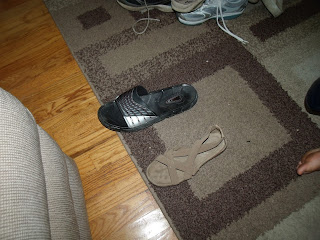Alex started his General Science through Apologia this week. We will be doing his own reading and his own experiments. This is the beginning of getting him into more independence as he reaches high school next year. Here are a couple experiments he had to work through today:
This one teaches about density. The liquids formed layers and the
solids floated at specific layers. This is the first lesson in learning
about atoms.
This second one taught him that hot atoms move faster than cold atoms. You can see in the red jar, which had cold water, that the coloring didn't mix as well as the green did, which was hot water.
Nicolas and I are working through Botany, one of the elementary studies from Apologia. He is learning about classifications and how taxonomists separate each living thing into a Kingdom, Phylum, Class, Order, Family, Genus and Species. His experiment was to use 1 of each pair of shoes in the house and separate them according to whatever he wanted to.
Here is the starting pile
Kingdom: Dress shoes
Kingdom: Slippers
Kingdom: Outside shoes
Kingdom: Tennis Shoes
Kingdom: Outside shoes, Phylums: Open toed and closed toed
Kingdom: Outside shoes, Phylum: Closed toed, Classes: With strings and without strings
Kingdom: Outside shoes, Phylum: Closed toed, Class: Without strings, Orders: Water Shoes & Sandals
Kingdom: Outside Shoes, Phylum: Open Toed, Classes: Thongs and no thongs
Kingdom: Outdoor shoes, Phylum: Open Toed, Class: Thongs, Orders: Black bottoms and other colored bottoms
Kingdom: Outdoor shoes, Phylum: Open Toed, Class: Thongs, Order: Black bottoms, Genuses: Cloth thong and plastic thong
Kingdom: Slippers, Phylums: Brown and other colors
Kingdom: Slippers, Phylum: Other colors, Classes: Open back and closed back
Kingdom: Tennis shoes, Phylum: Light and Dark
Kingdom: Tennis Shoes, Phylum: Light colored, Classes: Men's and Women's
Kingdom: Tennis Shoes, Phylum: Light colored, Classes: Women's, Orders: Open back and closed back
Kingdom: Tennis shoes, Phylum: Dark colored, Classes: Strings and No Strings
Kingdom: Tennis shoes, Phylum: Dark colored, Class: Strings, Orders: Cleated and non-cleated
Kingdom: Tennis Shoes, Phylum: Dark colored, Class: Strings, Order: Non-Cleated, Genuses: Men's and Women's
Kingdom: Dress shoes, Phylums: Heel and No Heel
Kingdom: Dress shoes, Phylum: Heeled, Classes: Open heel and closed heel
Kingdom: Dress shoes, Phylum: Heeled, Class: Closed heel, Order: Boot and Shoes
Kingdom: Dress shoes, Phylum: Heeled, Class: Closed heel, Order: Shoes, Genuses: Flat heel and "stick" heel
Kingdom: Dress shoes, Phylum: Open heel, Classes: Brown and White
Kingdom: Dress shoes, Phylum: No heel, Classes: Men's and Women's
Kingdom: Dress shoes, Phylum: Non heel, Class: Women's, Orders: Open toed and closed toed
Kingdom: Dress shoes, Phylum: Non heel, Class: Women's, Order: Closed toed, Genuses: Black and Brown
I think he did a good job and actually going through this long process helped him to really grasp what Taxonomy means.




































































